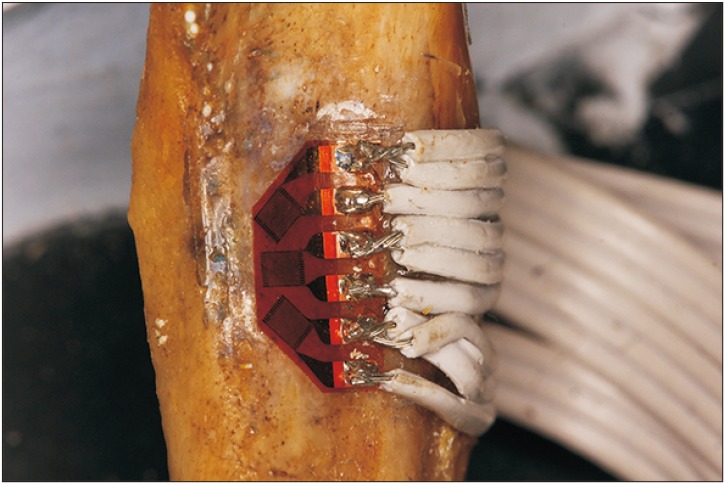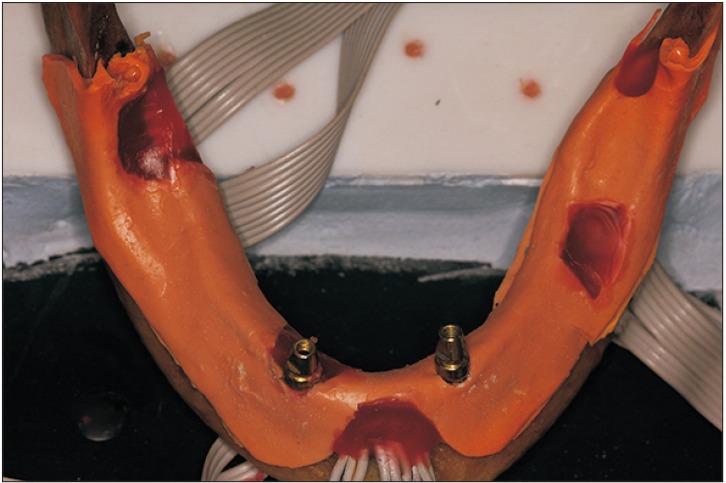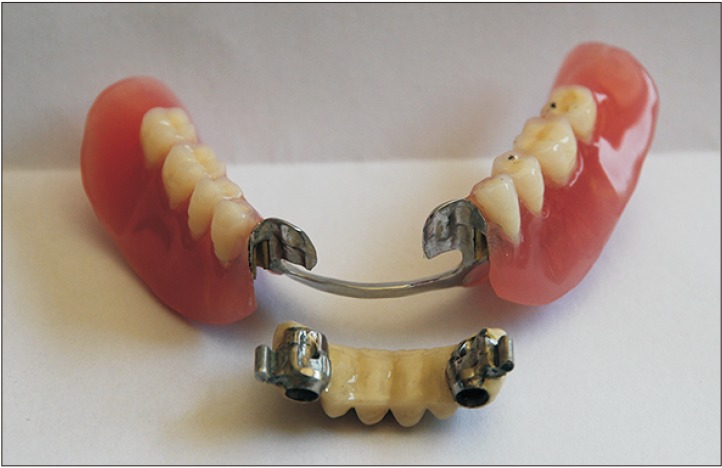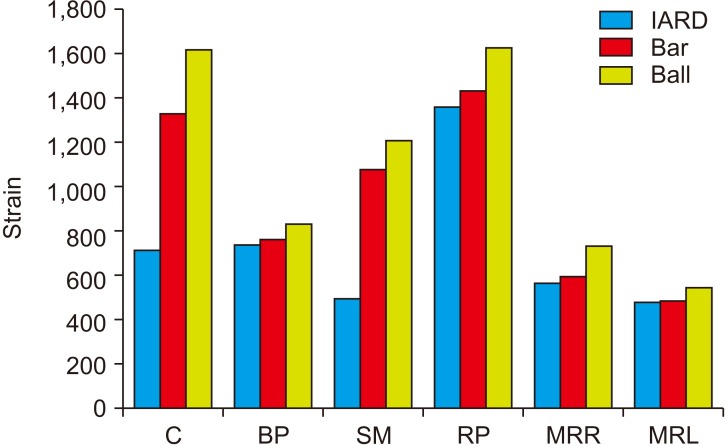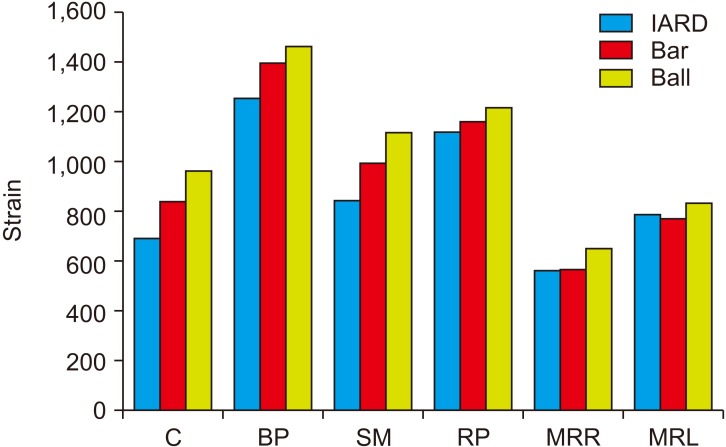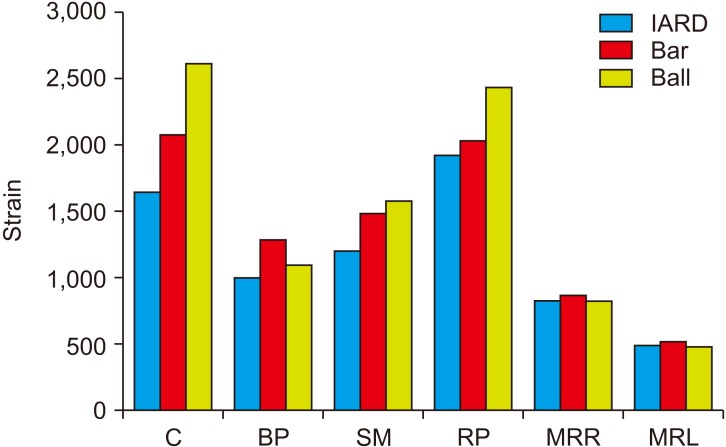J Korean Assoc Oral Maxillofac Surg.
2019 Aug;45(4):199-206. 10.5125/jkaoms.2019.45.4.199.
Evaluation of two interforaminal implants and implant-assisted removable dentures on stress distribution: an in vitro study
- Affiliations
-
- 1Private Office, Waltrop, Germany.
- 2Department of Prosthodontics, Faculty of Dentistry, Istanbul University, Istanbul, Turkey. geckili@istanbul.edu.tr
- 3Department of Prosthodontics, Faculty of Dentistry, Trakya University, Edirne, Turkey.
- 4Lab of Strength of Materials and Biomechanics, Faculty of Mechanical Engineering, Istanbul Technical University, Istanbul, Turkey.
- 5Department of Periodontology, School of Dentistry, Faculty of Health, University Witten/Herdecke, Witten, Germany.
- KMID: 2456038
- DOI: http://doi.org/10.5125/jkaoms.2019.45.4.199
Abstract
OBJECTIVES
In mandibular edentulism, the treatment option with a two-interforaminal implant-retained bridge and a removable partial denture is rarely evaluated in literature. The aim of this in vitro study was to evaluate the stress distribution of this treatment option by comparing it with traditional treatment options with interforaminal implants in the edentulous mandible.
MATERIALS AND METHODS
Two interforaminal implants were placed in a formalin-fixed cadaver mandible, and overdentures with three different types of attachments were fabricated: (1) two ball attachments and an overdenture, (2) a Dolder bar and an overdenture, and (3) screw-retained two-implant inter-canine porcelain fused to a metal bridge and an implant-assisted removable denture (IARD) with precision attachments. Three biting conditions were generated for each denture type, and the strains were documented under vertical loading of 100 N.
RESULTS
The calculated strain values from measured strains in all measurement sites and loading conditions for the screw-retained two-implant inter-canine porcelain fused to a metal bridge and a cast framework partial denture with precision attachments situation were lower than in the other scenarios (P<0.05).
CONCLUSION
Within the limitations of the present study, it can be concluded that an IARD may be a reasonable and valuable alternative to ball attachments or a bar in two interforaminal implants, especially when the patients prefer to be able to show their teeth even when they take out their removable dentures.
Keyword
MeSH Terms
Figure
Reference
-
1. Zarb GA, Schmitt A. The longitudinal clinical effectiveness of osseointegrated dental implants: the Toronto Study. Part II: the prosthetic results. J Prosthet Dent. 1990; 64:53–61. PMID: 2200880.
Article2. Burns DR, Unger JW, Elswick RK Jr, Beck DA. Prospective clinical evaluation of mandibular implant overdentures: part I--retention, stability, and tissue response. J Prosthet Dent. 1995; 73:354–363. PMID: 7783014.
Article3. Burns DR, Unger JW, Coffey JP, Waldrop TC, Elswick RK Jr. Randomized, prospective, clinical evaluation of prosthodontic modalities for mandibular implant overdenture treatment. J Prosthet Dent. 2011; 106:12–22. PMID: 21723989.
Article4. Ortegón SM, Thompson GA, Agar JR, Taylor TD, Perdikis D. Retention forces of spherical attachments as a function of implant and matrix angulation in mandibular overdentures: an in vitro study. J Prosthet Dent. 2009; 101:231–238. PMID: 19328276.
Article5. Geckili O, Bilhan H, Mumcu E, Dayan C, Yabul A, Tuncer N. Comparison of patient satisfaction, quality of life, and bite force between elderly edentulous patients wearing mandibular two implant-supported overdentures and conventional complete dentures after 4 years. Spec Care Dentist. 2012; 32:136–141. PMID: 22784321.
Article6. Geckili O, Bilhan H, Bilgin T. Impact of mandibular two-implant retained overdentures on life quality in a group of elderly Turkish edentulous patients. Arch Gerontol Geriatr. 2011; 53:233–236. PMID: 21183231.
Article7. Naert I, Alsaadi G, Quirynen M. Prosthetic aspects and patient satisfaction with two-implant-retained mandibular overdentures: a 10-year randomized clinical study. Int J Prosthodont. 2004; 17:401–410. PMID: 15382775.
Article8. Walton JN, Huizinga SC, Peck CC. Implant angulation: a measurement technique, implant overdenture maintenance, and the influence of surgical experience. Int J Prosthodont. 2001; 14:523–530. PMID: 12066698.9. Geckili O, Bilhan H, Bilgin T. Locator attachments as an alternative to ball attachments in 2-implant retained mandibular overdentures. J Can Dent Assoc. 2007; 73:691–694.10. Trakas T, Michalakis K, Kang K, Hirayama H. Attachment systems for implant retained overdentures: a literature review. Implant Dent. 2006; 15:24–34. PMID: 16569958.
Article11. Heckmann SM, Winter W, Meyer M, Weber HP, Wichmann MG. Overdenture attachment selection and the loading of implant and denture-bearing area. Part 2: a methodical study using five types of attachment. Clin Oral Implants Res. 2001; 12:640–647. PMID: 11737109.
Article12. Osman RB, Payne AG, Ma S. Prosthodontic maintenance of maxillary implant overdentures: a systematic literature review. Int J Prosthodont. 2012; 25:381–391. PMID: 22720290.13. Bakke M, Holm B, Gotfredsen K. Masticatory function and patient satisfaction with implant-supported mandibular overdentures: a prospective 5-year study. Int J Prosthodont. 2002; 15:575–581. PMID: 12475165.14. Bergendal T, Engquist B. Implant-supported overdentures: a longitudinal prospective study. Int J Oral Maxillofac Implants. 1998; 13:253–262. PMID: 9581412.15. Karabuda C, Tosun T, Ermis E, Ozdemir T. Comparison of 2 retentive systems for implant-supported overdentures: soft tissue management and evaluation of patient satisfaction. J Periodontol. 2002; 73:1067–1070. PMID: 12296593.
Article16. MacEntee MI, Walton JN, Glick N. A clinical trial of patient satisfaction and prosthodontic needs with ball and bar attachments for implant-retained complete overdentures: three-year results. J Prosthet Dent. 2005; 93:28–37. PMID: 15623995.
Article17. Mumcu E, Bilhan H, Geckili O. The effect of attachment type and implant number on satisfaction and quality of life of mandibular implant-retained overdenture wearers. Gerodontology. 2012; 29:e618–e623. PMID: 21726276.
Article18. Kleis WK, Kämmerer PW, Hartmann S, Al-Nawas B, Wagner W. A comparison of three different attachment systems for mandibular two-implant overdentures: one-year report. Clin Implant Dent Relat Res. 2010; 12:209–218. PMID: 19416278.
Article19. Cune M, van Kampen F, van der Bilt A, Bosman F. Patient satisfaction and preference with magnet, bar-clip, and ball-socket retained mandibular implant overdentures: a cross-over clinical trial. Int J Prosthodont. 2005; 18:99–105. PMID: 15889656.
Article20. Davis DM, Packer ME. Mandibular overdentures stabilized by Astra Tech implants with either ball attachments or magnets: 5-year results. Int J Prosthodont. 1999; 12:222–229. PMID: 10635189.21. Chaytor DV, Zarb GA, Schmitt A, Lewis DW. The longitudinal effectiveness of osseointegrated dental implants. The Toronto Study: bone level changes. Int J Periodontics Restorative Dent. 1991; 11:112–125. PMID: 1938184.22. Donatsky O. Osseointegrated dental implants with ball attachments supporting overdentures in patients with mandibular alveolar ridge atrophy. Int J Oral Maxillofac Implants. 1993; 8:162–166. PMID: 8359871.23. Boerrigter EM, van Oort RP, Raghoebar GM, Stegenga B, Schoen PJ, Boering G. A controlled clinical trial of implant-retained mandibular overdentures: clinical aspects. J Oral Rehabil. 1997; 24:182–190. PMID: 9131473.
Article24. Burns DR. Mandibular implant overdenture treatment: consensus and controversy. J Prosthodont. 2000; 9:37–46. PMID: 11074027.
Article25. Naert I, Alsaadi G, van Steenberghe D, Quirynen M. A 10-year randomized clinical trial on the influence of splinted and unsplinted oral implants retaining mandibular overdentures: peri-implant outcome. Int J Oral Maxillofac Implants. 2004; 19:695–702. PMID: 15508985.
Article26. Cehreli MC, Karasoy D, Kökat AM, Akça K, Eckert S. A systematic review of marginal bone loss around implants retaining or supporting overdentures. Int J Oral Maxillofac Implants. 2010; 25:266–277. PMID: 20369084.27. Roos-Jansåker AM, Franke-Stenport V, Renvert S, Albrektsson T, Claffey N. Dog model for study of supracrestal bone apposition around partially inserted implants. Clin Oral Implants Res. 2002; 13:455–459. PMID: 12453120.
Article28. Brunski J, Block MS, Guerra LR. Biomechanics of dental implants. In : Block MS, Kent JN, Guerra L, editors. Implants in dentistry: essentials of endosseous implants for maxillofacial reconstruction. Philadelphia: W.B. Saunders;1997. p. 63–71.29. Bilhan H, Mumcu E, Arat S. The comparison of marginal bone loss around mandibular overdenture-supporting implants with two different attachment types in a loading period of 36 months. Gerodontology. 2011; 28:49–57. PMID: 19682097.30. Bergkvist G, Simonsson K, Rydberg K, Johansson F, Dérand T. A finite element analysis of stress distribution in bone tissue surrounding uncoupled or splinted dental implants. Clin Implant Dent Relat Res. 2008; 10:40–46. PMID: 18254739.
Article31. Bassetti RG, Bassetti MA, Kuttenberger J. Implant-assisted removable partial denture prostheses: a critical review of selected literature. Int J Prosthodont. 2018; 31:287–302. PMID: 29723327.
Article32. Wismeijer D, Tawse-Smith A, Payne AG. Multicentre prospective evaluation of implant-assisted mandibular bilateral distal extension removable partial dentures: patient satisfaction. Clin Oral Implants Res. 2013; 24:20–27.
Article33. Payne AG, Tawse-Smith A, Wismeijer D, De Silva RK, Ma S. Multicentre prospective evaluation of implant-assisted mandibular removable partial dentures: surgical and prosthodontic outcomes. Clin Oral Implants Res. 2017; 28:116–125. PMID: 26799154.
Article34. Starr NL. The distal extension case: an alternative restorative design for implant prosthetics. Int J Periodontics Restorative Dent. 2001; 21:61–67. PMID: 11829037.35. Feinberg E. Precision attachment case restoration with implant abutments: a review with case reports. J Oral Implantol. 2011; 37:489–498. PMID: 20553159.
Article36. Pellecchia M, Pellecchia R, Emtiaz S. Distal extension mandibular removable partial denture connected to an anterior fixed implant-supported prosthesis: a clinical report. J Prosthet Dent. 2000; 83:607–612. PMID: 10842125.
Article37. Chronopoulos V, Sarafianou A, Kourtis S. The use of dental implants in combination with removable partial dentures: a case report. J Esthet Restor Dent. 2008; 20:355–364. discussion 365. PMID: 19120779.
Article38. Bilhan H. The role of the dental implant in removable partial dentures. In : Şakar O, editor. Removable partial dentures: a practitioners' manual. Cham: Springer International Publishing;2016. p. 195–208.39. English CE. Bar patterns in implant prosthodontics. Implant Dent. 1994; 3:217–229. PMID: 7663462.
Article40. Machado AC, Cardoso L, Brandt WC, Henriques GE, de Arruda Nóbilo MA. Photoelastic analysis of the distribution of stress in different systems of overdentures on osseous-integrated implants. J Craniofac Surg. 2011; 22:2332–2336. PMID: 22134270.
Article41. Nishioka RS, de Vasconcellos LG, de Melo Nishioka LN. External hexagon and internal hexagon in straight and offset implant placement: strain gauge analysis. Implant Dent. 2009; 18:512–520. PMID: 20009605.
Article42. Rangert B, Gunne J, Glantz PO, Svensson A. Vertical load distribution on a three-unit prosthesis supported by a natural tooth and a single Brånemark implant. An in vivo study. Clin Oral Implants Res. 1995; 6:40–46. PMID: 7669866.
Article43. Haruta A, Matsushita Y, Tsukiyama Y, Sawae Y, Sakai N, Koyano K. Effects of mucosal thickness on the stress distribution and denture stability of mandibular implant-supported overdentures with unsplinted attachments in vitro. J Dent Biomech. 2011; 2011:894395. PMID: 21799705.44. Menicucci G, Lorenzetti M, Pera P, Preti G. Mandibular implant-retained overdenture: finite element analysis of two anchorage systems. Int J Oral Maxillofac Implants. 1998; 13:369–376. PMID: 9638007.45. Thayer HH, Caputo AA. Photoelastic stess analysis of overdenture attachments. J Prosthet Dent. 1980; 43:611–617. PMID: 6989977.
- Full Text Links
- Actions
-
Cited
- CITED
-
- Close
- Share
- Similar articles
-
- Mandibular implant assisted removable partial denture with a small number of implant crowns: two case reports
- Implant-assisted removable partial denture restoration in a partially edentulous patient with a single remaining tooth: a case report
- The use of implant-assisted removable partial denture in the partially edentulous maxilla with a few unilateral remaining teeth and implant overdenture in the mandible: A case report
- Rehabilitation of maxillary partial edentulous patients using implant assisted removable partial denture
- Influence of the length and location of implants on distal extension removable partial dentures: finite element analysis

